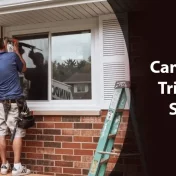Hurricanes, with their unmatched fury and potential for devastation, have long been a subject of intrigue and concern.
But as we confront these natural phenomena, one of the most potent tools at our disposal is knowledge.
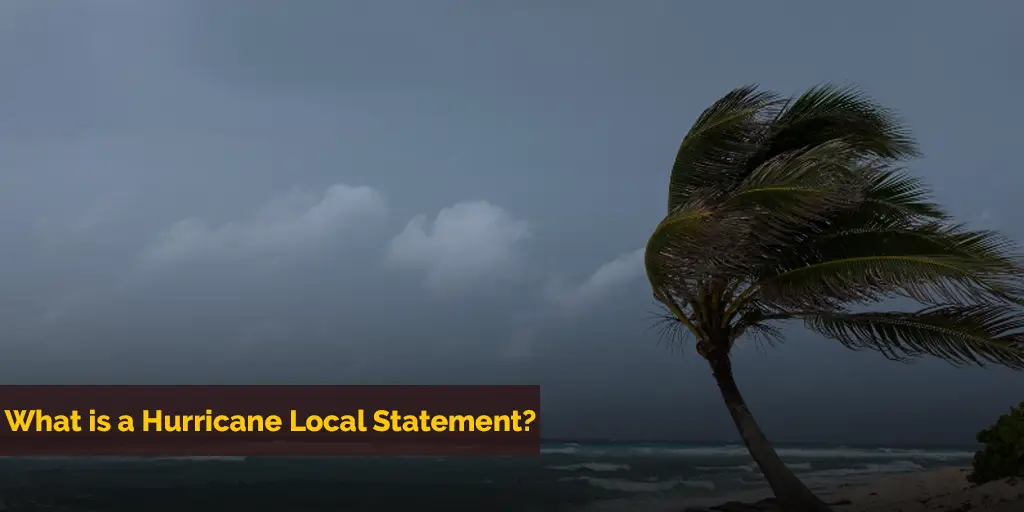
A hurricane local statement provides just that – detailed, localized insights into an approaching storm, enabling communities to prepare, respond, and recover.
But what exactly is a hurricane local statement? How has technology transformed our ability to forecast these mighty storms, and why is it crucial to stay updated with local weather forecast offices?
In this comprehensive guide, we’ll delve deep into the intricacies of a hurricane local statement, its significance, and how it fits into the broader tapestry of meteorological science and public safety.
From understanding its core components to the historical hurricanes that have shaped our approach to storm prediction and response, we aim to equip you with the knowledge to face these natural challenges head-on.
What Is A Hurricane Statement?
A hurricane local statement is an essential piece of information released by local weather forecast offices, especially during the times when areas affected by storm intensities are at a high risk.
These statements offer residents a clear picture of the impending weather conditions, helping them make informed evacuation decisions.
When a tropical storm or hurricane is approaching, understanding these statements becomes paramount for the safety of the community.
The primary purpose of these statements is to provide the public and local officials with specific details about the precautions necessary to protect life and property.
Originating from the National Hurricane Center and distributed by local weather forecast offices across the United States, these statements offer a blend of automated and human-driven components, ensuring accuracy and timeliness.
A notable example of the importance of hurricane local statements is the case of Hurricane Katrina. The timely issuance of local statements played a pivotal role in informing residents about the severity of the impending storm surge flood and the necessary actions to be taken.
The process of issuing a hurricane local statement is meticulous, with experts relying on data from the National Digital Forecast Database, graphical products, and other sources.
It’s not just about identifying potential impacts; it’s about saving lives and ensuring that everyone—residents and local officials alike—has the most accurate, up-to-date storm information at their fingertips.
What Information Is Given In A Hurricane Statement?
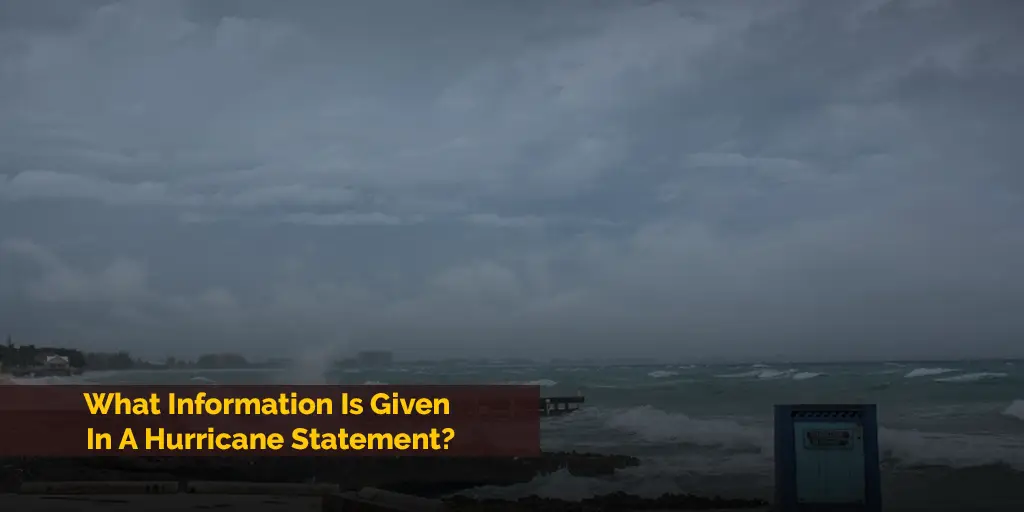
When a tropical cyclone, be it a tropical storm or hurricane, is nearing, local weather forecast offices in collaboration with the National Hurricane Center release a hurricane local statement.
This statement is packed with crucial information tailored to the specific areas affected, providing a localized perspective that generic storm updates might not cover.
What To Expect?
A comprehensive hurricane local statement typically includes the following components:
- Storm Intensities: A breakdown of the expected storm intensities, ranging from light drizzles to torrential downpours and fierce winds. The distinction between a tropical storm and a full-blown hurricane is clearly made, allowing residents to grasp the severity of the impending weather conditions.
- Graphical Product: Visual representations, often pulled from the National Digital Forecast Database, that showcase the projected path of the storm, areas of highest risk, and other vital storm information.
- Tropical Cyclone Watches and Warnings: Timely updates on the tropical cyclone watches and warnings in effect, enabling residents to prepare and respond accordingly.
- Potential Impacts: A detailed analysis of the potential impacts, such as storm surge flood risks, property damage estimates, and possible disruptions in day-to-day activities.
- Precautions: Based on the provided storm information, a list of recommended precautions necessary to protect life and property is provided. This could range from securing loose outdoor items to full-scale evacuations as advised by local officials.
- Timestamp: Each statement is clearly timestamped, for instance, “PM EDT,” ensuring residents are viewing the most recent and relevant information.
It’s worth noting that a local statement will be issued multiple times as a storm progresses, reflecting the evolving nature of weather conditions and the dynamic responses required.
The collaboration between the National Hurricane Center and local weather forecast offices ensures that these updates are both accurate and timely.
Given the unpredictability of tropical storms and hurricanes, residents are often urged to stay updated through official channels and heed the advice of local officials.
After all, these statements are a blend of both automated processes and human expertise, striking a balance between technological precision and human judgment.
What Should You Do Following A Hurricane Statement?
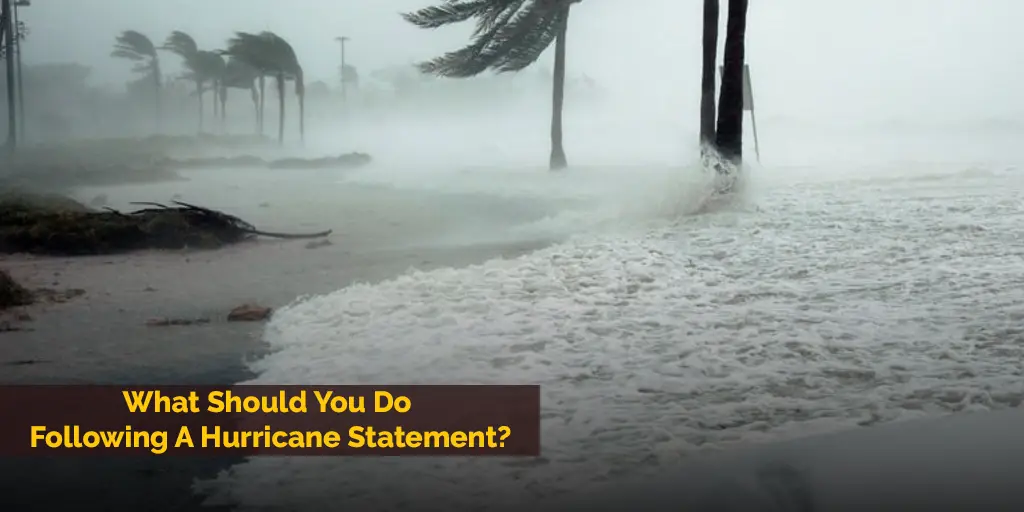
Once a hurricane local statement is released, it’s essential not just to understand its content but also to take prompt action.
Both the National Hurricane Center and local weather forecast offices aim to provide residents with the most accurate storm information, but it’s up to individuals to make weather conditions evacuation decisions that ensure their safety and that of their loved ones.
Key Actions to Consider:
Stay Updated:
Always keep a close eye on subsequent local statements. As tropical storm or hurricane conditions evolve, new statements will be issued to reflect the latest developments. This ensures that you’re acting on the most up-to-date information.
Heed Local Officials’ Advice:
Local officials, having a grasp of the areas affected, will provide guidance on the best course of action, whether it’s to evacuate or to stay put. Their directives are based on the potential impacts highlighted in the statement and other critical data.
Prepare for Potential Impacts:
Based on the hurricane local statement, get ready for the forecasted impacts. This could mean reinforcing your home against expected hurricane conditions, preparing for power outages, or gathering essential supplies in anticipation of disruptions.
Evacuation Plans:
If the statement indicates a severe threat level, such as a significant storm surge flood risk, and local officials advise evacuation, ensure you’re aware of the designated evacuation routes. Prepare a kit with essential items, and if you have pets, make arrangements for their safety as well.
Communicate with Neighbors:
In times of impending tropical storms or hurricanes, community collaboration can be a lifeline. Share the information from the local statement with neighbors, especially if they might not have access to the latest updates. Discuss collective preparation measures and ensure everyone is on the same page.
Avoid Rumors:
With the advent of social media and various communication channels, misinformation can spread quickly. Always rely on official sources, like the National Hurricane Center and local weather forecast offices, for accurate storm information.
Remember, the primary purpose of the hurricane local statement is to inform residents about the precautions necessary to protect life and property.
While the statement provides a wealth of information, taking timely and informed actions is crucial to navigating the challenges posed by tropical storms and hurricanes effectively.
Hurricane Statement Compared to Other Weather Warnings
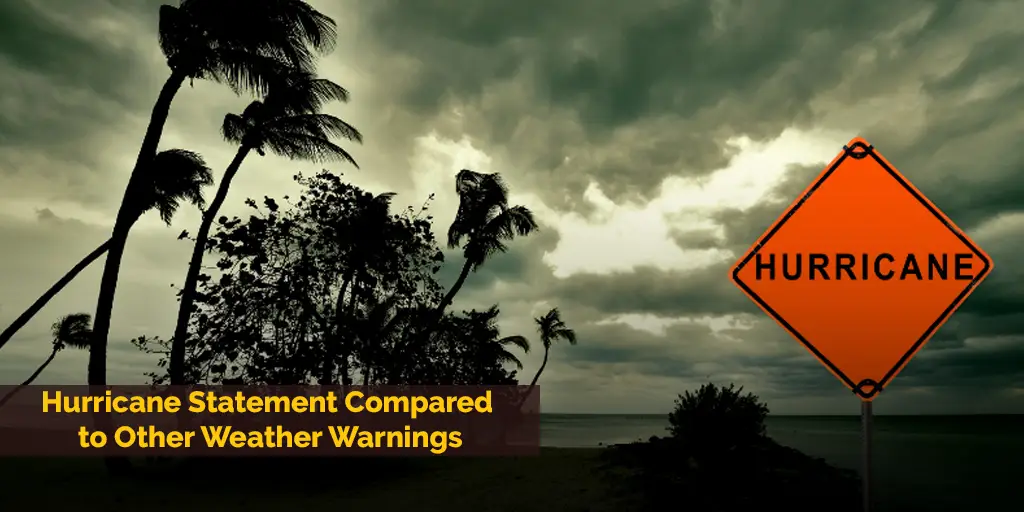
Weather warnings come in various forms, each tailored to specific threats and conditions. While the hurricane local statement is crucial during tropical storms and hurricanes, it’s essential to understand how it differs from other weather warnings to grasp its unique significance.
Key Differences:
Scope of Information: A hurricane local statement is a comprehensive document that provides a detailed breakdown of a tropical storm or hurricane’s expected impacts. In contrast, other weather warnings, such as tornado or thunderstorm alerts, might focus solely on the immediate threat without the broader context.
Issuing Authority: While the hurricane local statement is a collaborative effort between the National Hurricane Center and local weather forecast offices in the United States, other warnings might be issued by state-specific meteorological departments or international weather organizations.
Geographical Relevance: These statements are tailored to specific areas affected by the storm, offering localized information. On the other hand, general weather warnings might cover broader regions without the same level of localized detail.
Duration and Updates: Given the prolonged and evolving nature of tropical storms and hurricanes, local statements are updated frequently to reflect changing conditions. Other weather warnings, especially for short-lived events, might not see the same frequency of updates.
Safety Recommendations: A hurricane local statement provides a detailed list of precautions necessary to protect life and property, considering the multifaceted threats posed by hurricanes—from storm surge floods to high winds. Other warnings might have more singular safety advice, focusing on the specific danger at hand.
For instance, while a warning about a tornado would emphasize seeking immediate shelter, a hurricane local statement might delve into preparing your home, evacuation routes, and even post-storm safety measures.
Understanding the nuances between a hurricane local statement and other weather warnings ensures residents can respond appropriately to each threat, maximizing safety and minimizing potential impacts.
Safety Tips During A Hurricane

When faced with the looming threat of a tropical storm or hurricane, it’s imperative to be well-prepared and informed.
A hurricane local statement provides vital storm information, but knowing general safety protocols can be the difference between safety and catastrophe.
Essential Safety Measures:
- Evacuate If Necessary: If local officials advise evacuation due to the potential impacts of the storm, heed their advice promptly. Know your evacuation routes, have a pre-packed emergency kit, and ensure you leave well before the storm intensifies.
- Hurricane Proof Your Home: Reinforce windows with storm shutters or plywood. Secure outdoor furniture and other loose items to prevent them from becoming projectiles during strong winds. Clear drains and gutters to prevent flooding.
- Stay Indoors: During the hurricane, stay indoors and away from windows, skylights, and glass doors. Find a safe room in your home, ideally one without windows, such as a bathroom or closet.
- Have A Plan: Discuss with family members what to do in case of emergencies. Ensure everyone knows evacuation routes and emergency contacts. Establish a meeting point in case you get separated.
- Keep Up To Date With Local News: Regularly check updates from local weather forecast offices and the National Hurricane Center. Stay informed about the storm’s progression and any new advisories or warnings.
Emergency Essentials:
Having an emergency kit prepared can be a lifesaver. Here’s what it should include:
| Item | Purpose |
|---|---|
| Flashlight & Batteries | For power outages and navigating in the dark. |
| First Aid Kit | To treat minor injuries. |
| Non-perishable Food | Sustenance in case of prolonged power outages. |
| Water | At least one gallon per person per day for several days. |
| Medications | Essential medicines and prescriptions. |
| Important Documents | Passports, insurance papers, medical records, etc. |
| Portable Charger | To keep phones and other devices charged. |
| Cash | In case electronic transactions are not possible. |
Preparation is the key to navigating the challenges posed by hurricanes. By following the safety tips and ensuring you have all essentials at hand, you can minimize risks and protect yourself and your loved ones.
Emergency Hurricane Kit
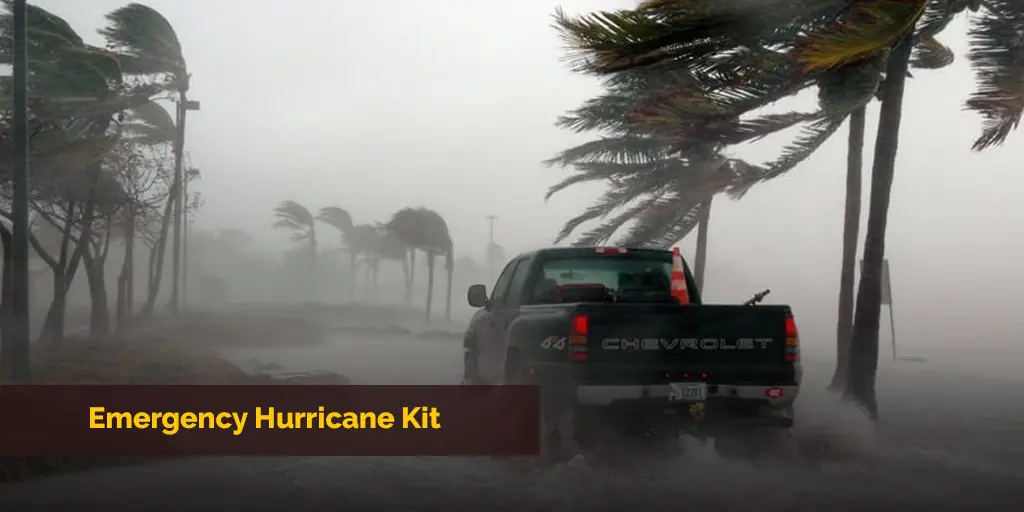
An emergency hurricane kit is a collection of essential items that you’ll need to stay safe and sustain yourself during and after a tropical storm or hurricane.
While a hurricane local statement provides detailed information about the storm, having an emergency kit ready ensures you’re prepared for the aftermath and any unforeseen challenges.
Essentials for Your Kit:
- Flashlight: Power outages are common during hurricanes. A reliable flashlight with extra batteries can help you navigate in the dark.
- First Aid Kit: Accidents can happen, especially during storms. A well-equipped first aid kit can help treat minor injuries and stabilize conditions until medical help is available.
- Tool: Multi-functional tools can assist in minor repairs, opening cans, or cutting through obstructions.
- Clean Supplies: Hygiene is crucial, especially if water supply gets disrupted. Include hand sanitizers, wet wipes, and other cleaning supplies.
- Portable Charger: Ensure your phones and communication devices remain charged. A portable charger, preferably solar-powered, can be a lifeline in prolonged power outages.
- Documents: Keep essential documents like identification, insurance papers, medical records, and bank details in a waterproof pouch.
- Whistle: In case you need to signal for help, a loud whistle can be more effective than shouting.
- Lighter Or Matches: Useful for lighting candles or a cooking fire if you’re in a place without power for an extended period.
Food and Water:
It’s vital to have a stock of non-perishable food items and clean water. Here’s what you should consider:
| Food Type | Quantity Suggestion |
|---|---|
| Canned Foods | Fruits, vegetables, and ready-to-eat meals. |
| Dry Foods | Crackers, cereal, and energy bars. |
| Nuts & Seeds | Almonds, peanuts, and sunflower seeds for quick energy. |
| Water | At least one gallon per person per day for several days. |
Remember, the aftermath of a hurricane can be as challenging as the storm itself. Roads may be blocked, stores closed, and utilities disrupted.
An emergency kit ensures you’re self-reliant during such times, reducing dependency on external aid and increasing your safety.
What Food Will You Need to Stock Up On?
In the event of a tropical storm or hurricane, having an ample supply of non-perishable food is crucial. As highlighted in the hurricane local statement, these storms can disrupt daily life for days or even weeks.
Stores might be closed, roads could be blocked, and power outages can make cooking a challenge. Here’s a comprehensive list of food items you should consider stocking up on:
Essential Food Items:
Canned Goods:
- Proteins: Canned tuna, chicken, salmon, and beans provide essential proteins.
- Vegetables: Canned green beans, carrots, peas, and corn can be eaten without heating.
- Fruits: Canned pineapples, peaches, and pears are rich in vitamins and can satisfy sugar cravings.
- Soups & Broths: These can be heated on a portable stove or eaten at room temperature.
Dry Foods:
- Grains: Rice, quinoa, and instant oatmeal packets.
- Pasta: Quick-cooking noodles and pasta that require minimal preparation.
- Crackers & Biscuits: These can be paired with canned goods or eaten as snacks.
Snacks:
- Energy Bars: Nutrient-dense bars that can provide quick energy.
- Nuts & Seeds: Almonds, walnuts, and sunflower seeds are both nutritious and filling.
- Dried Fruits: Raisins, apricots, and dates can be a sweet treat and energy source.
Drinks:
- Water: Essential for drinking, cooking, and hygiene. Stock up on at least one gallon per person per day.
- Sports Drinks: Useful for staying hydrated and replenishing lost electrolytes.
- Instant Coffee & Tea: For those who need their caffeine fix.
- Special Dietary Needs: If someone in your household has specific dietary requirements, allergies, or medical conditions, ensure you stock food that caters to their needs.
Remember, the key is to have food items that require minimal preparation, have a long shelf life, and can provide the necessary nutrients to sustain you and your family.
Always check the expiration dates and store food in a cool, dry place. Rotate your stock periodically to ensure you’re consuming items before they expire.
How Should You Prepare for an Evacuation Caused by a Hurricane?
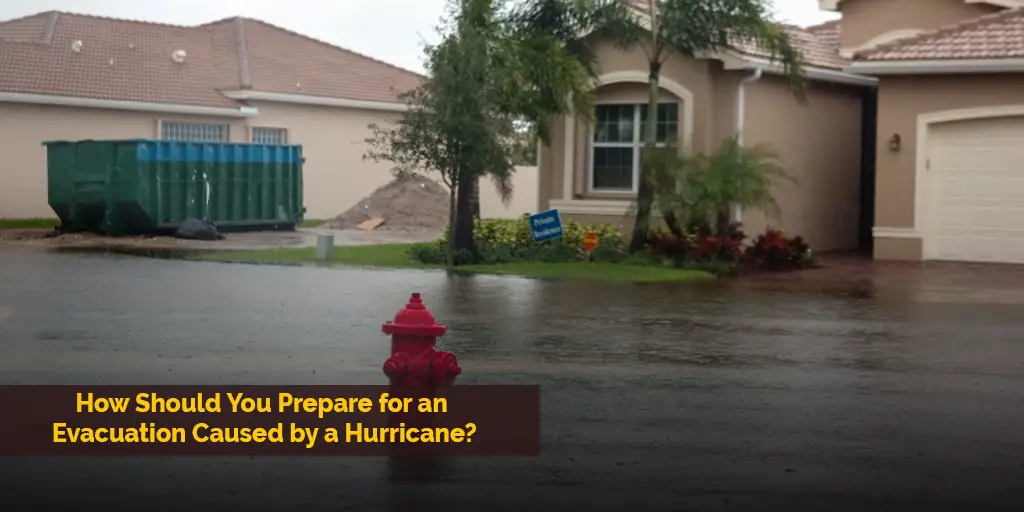
An evacuation, as recommended by local officials based on the hurricane local statement, can be a daunting experience.
However, with proper planning and preparation, you can ensure the safety of your family and property. Here are some steps to consider:
Steps to Prepare for Evacuation:
- Be Aware Of The Evacuation Route: Familiarize yourself with designated evacuation routes. Local weather forecast offices and other official channels usually provide maps and directions. It’s essential to have a physical map in case digital devices fail.
- Get Your Supplies Together: Prepare an evacuation kit. This should include:
- Essential documents (in a waterproof pouch)
- Medications and first aid kit
- Non-perishable food and water
- Flashlights, batteries, and portable chargers
- Cash and credit cards
- Clothing and personal items for several days
- Plan For Disabilities: If someone in your household has a disability, ensure that you have the necessary equipment or aids they might need, such as wheelchairs, hearing aids, or other medical equipment.
- Pets: Your pets are part of your family. Prepare a separate evacuation kit for them, including:
- Food and water
- Leash, harness, or carrier
- Medications and medical records
- A picture of you and your pet together (in case you get separated)
- Staying With Family Or Friends: If you plan to evacuate to a family or friend’s house, communicate with them in advance. Ensure they have the capacity to accommodate you and your family, and check if the area they reside in is safe from the storm’s impacts.
- Vehicle Preparation: Ensure your vehicle is in good working condition. Fill up the gas tank, check the battery, tires, and brakes. Keep an emergency kit in the car, which includes jumper cables, flares, tools, and a spare tire.
- Stay Informed: Continuously monitor the situation through the National Hurricane Center, local weather forecast offices, and other official channels. Evacuate as soon as the recommendation is made.
Evacuations can be challenging, but they are crucial for safety during severe tropical storms or hurricanes. By planning ahead and being prepared, you can minimize the stress and ensure the well-being of your loved ones.
How Should You Prepare Your Home for a Hurricane?
While personal safety is paramount during a hurricane, taking precautions to protect your property can mitigate potential damage and save on costly repairs. Here’s a comprehensive guide on how to prepare your home before a tropical storm or hurricane hits:
Home Preparation Checklist:
- Windows & Doors:
- Install storm shutters or board up windows using plywood to prevent breakage.
- Reinforce doors, especially the garage door, which can be vulnerable to strong winds.
- Roof:
- Ensure it’s in good condition and fix any loose tiles or shingles.
- Consider strapping the roof to the house frame to provide extra resistance against strong winds.
- Outdoor Area:
- Secure or bring inside outdoor furniture, decorations, garbage cans, and other items that could become windborne projectiles.
- Trim trees and shrubs to make them more wind-resistant.
- Drains & Gutters:
- Clean out gutters and downspouts to ensure proper drainage and prevent water damage.
- Check local drains and ditches to ensure they are not blocked.
- Utilities:
- Turn off utilities as instructed by local officials.
- Turn off propane tanks to prevent leaks or explosions.
- Electrical Equipment:
- Elevate major appliances above potential flood levels if you’re in a zone vulnerable to flooding.
- Install a surge protector to safeguard electrical appliances from voltage spikes.
- Water:
- If there’s a possibility of water contamination, fill bathtubs and large containers with fresh water. This can be used for drinking, flushing toilets, and hygiene.
- Home Insurance:
- Review your insurance policy to ensure you have adequate coverage for potential damages.
- Document the state of your property by taking photos or videos. This can be useful for insurance claims.
- Stay Informed:
- Keep an eye on updates from the National Hurricane Center and local weather forecast offices.
- Install a weather app or get a battery-powered weather radio to stay updated even during power outages.
By taking these precautions, you can significantly reduce the risk of damage to your home. Remember, while properties can be repaired or rebuilt, lives cannot. Always prioritize personal safety over property protection.
What Should You Do When the Hurricane Has Passed?
Once the storm subsides, the immediate danger might be over, but there are still potential hazards and essential tasks to address. Here’s what you should consider doing after a tropical storm or hurricane:
Post-Hurricane Checklist:
- Check In With Loved Ones And Neighbors:
- Ensure the safety of your family members.
- Assist neighbors, especially the elderly, children, or those with disabilities.
- Assess Damage Carefully:
- Before entering your home, check for structural damage.
- Be wary of gas leaks, damaged electrical wires, and compromised water systems.
- Document Damage:
- Take photos and videos of any damage to your property. This will be invaluable for insurance claims.
- List down any damaged or lost items.
- Avoid Floodwaters:
- Standing water can be electrically charged due to fallen power lines.
- It can also be contaminated with sewage or contain hidden debris.
- Monitor News:
- Stay informed about the situation in your area via local news, the National Hurricane Center, and local weather forecast offices.
- There might be new advisories on road conditions, water safety, or other essential services.
- Conserve Supplies:
- Even after the storm, there might be disruptions in services or access to supplies.
- Conserve food, water, and other essentials until normalcy is restored.
- Disaster Relief:
- Check if there are local disaster relief services or shelters providing aid or supplies.
- Organizations like the Red Cross often offer assistance in the aftermath of severe storms.
- Contact Insurance:
- Initiate the process of claiming insurance for any damages to your property.
- Provide all necessary documentation and cooperate with adjusters.
- Avoid Driving:
- Stay off roads to allow emergency vehicles to pass.
- If you must drive, be cautious of flooded roads, downed power lines, and debris.
- Restore Utilities:
- Once it’s safe, turn on utilities. If you suspect any damage, seek professional assistance.
Remember, the aftermath of a hurricane can be as challenging as the storm itself. It’s essential to stay cautious, patient, and informed. In rebuilding and recovery, community collaboration can be invaluable.
Stick together, help one another, and you’ll find the strength to overcome the challenges.
Will Your Home Insurance Cover Hurricane Damage?
Understanding your home insurance coverage is crucial, especially if you live in an area frequently affected by tropical storms or hurricanes.
After the storm, as you assess the damage, one of the primary concerns is the financial aspect of repairs and recovery.
Key Points to Consider:
- Standard Homeowners Insurance:
- Most standard policies cover wind damage from hurricanes. However, flood damage, which is often a significant result of hurricanes, is typically not covered.
- If you’re in a flood-prone area, it’s advisable to purchase separate flood insurance.
- Deductibles:
- Some insurance policies have a hurricane deductible, separate from the standard deductible. This could be a percentage of the home’s insured value rather than a specific dollar amount.
- Additional Living Expenses:
- If the hurricane makes your home uninhabitable, some insurance policies cover additional living expenses. This can include hotel stays, meals, and other costs.
- Personal Property Coverage:
- Check if your policy covers the replacement cost of personal items or just their actual cash value. The former pays to replace the items, while the latter considers depreciation.
- Flood Insurance:
- As mentioned, flood damage is typically not covered under standard homeowners’ insurance. Separate flood insurance can be purchased through the National Flood Insurance Program (NFIP) or private insurers.
- Document Everything:
- Keep a record of all communication with the insurance company.
- Document the damage with photos and videos.
- Keep receipts for any repair work or additional expenses.
- Review and Update:
- It’s advisable to review your insurance policy annually and understand any changes.
- Ensure your coverage is adequate, considering the value of your home and belongings.
In the wake of a hurricane, dealing with insurance can be overwhelming. However, being well-informed and proactive can simplify the process.
If in doubt, consult with an insurance agent or a professional to understand the nuances of your policy better.
How to Claim on Home Insurance for Hurricane Damage?
If a hurricane has caused damage to your property, navigating the insurance claim process can be a daunting task.
However, with a systematic approach, you can ensure a smoother claim experience and get the financial support needed for repairs and recovery.
Steps to File a Claim:
- Immediate Documentation:
- As soon as it’s safe, document the damage. Take clear photos and videos of all affected areas. This provides evidence for your claim.
- Contact Your Insurance Company:
- Inform them about the damage as soon as possible. They will provide guidance on the next steps and what information they require.
- Review Your Policy:
- Understand the coverage limits, deductibles, and any specific requirements. Knowing what’s covered and what’s not can help set expectations.
- Temporary Repairs:
- To prevent further damage, make temporary repairs. For instance, if there’s a broken window, board it up. Always keep the receipts for any materials or services used.
- Adjuster’s Visit:
- The insurance company will send an adjuster to assess the damage. Be present during this visit and provide all necessary documentation. The adjuster’s assessment determines the claim amount.
- Maintain Records:
- Keep a log of all communications with the insurance company. Note down dates, names of representatives, and the content of the discussions.
- Claim Forms:
- Fill out claim forms diligently. Ensure all information is accurate and complete. Any discrepancies can delay the process.
- Get Multiple Estimates:
- For repair work, get estimates from multiple contractors. This gives you a fair idea of the costs and helps in negotiations with the insurance company.
- Stay Patient:
- Insurance claims, especially in the aftermath of a significant event like a hurricane, can take time. While it’s essential to be proactive, patience is crucial.
- Know Your Rights:
- If there’s a dispute with the insurance company or you feel the claim amount is unfair, you have the right to challenge. Consider hiring a public adjuster or seeking legal advice.
- Receive Payment:
- Once the claim is approved, the insurance company will provide compensation. Understand the payment terms, whether it’s a lump sum or in installments.
While the aftermath of a hurricane is challenging, being informed and organized can make the insurance claim process more manageable.
Always prioritize safety and ensure you take the necessary precautions to protect both life and property.
How to Protect Your Pets During a Hurricane?
Pets are beloved members of many families, and their safety during a hurricane is a paramount concern.
As you prepare for a storm, based on the guidance from a hurricane local statement, it’s essential to have a plan in place for your pets too.
Pet Safety Tips:
- Emergency Kit for Pets:
- Just as you’d prepare an emergency kit for your family, do the same for your pets. This should include:
- Food and water for several days
- Medications and medical records in a waterproof container
- Leash, harness, or carrier for transporting
- Updated ID tags and a recent photo of your pet
- Evacuation Plans:
- If you’re advised to evacuate, never leave your pets behind. They could get lost or be exposed to numerous dangers.
- Know pet-friendly shelters or accommodations ahead of time.
- Keep Them Calm:
- Hurricanes can be distressing for pets due to loud noises and changes in the environment. Keep them in a quiet, safe space and stay with them if possible.
- Identification:
- Ensure your pets wear collars with updated identification tags. Consider microchipping them for added security.
- Avoid Floodwaters:
- After the storm, keep pets away from floodwaters which could contain harmful bacteria or hidden dangers.
- Stay Informed:
- Keep an eye on updates from local weather forecast offices and other official channels. Follow their guidance regarding pet safety.
- Health Check:
- After the storm, check your pets for any injuries or signs of distress. Consult a veterinarian if necessary.
- Limit Outdoor Time:
- Post-hurricane conditions might not be safe for pets to roam outside freely. Limit their outdoor activities until you’re sure the environment is safe.
- Familiarize with Local Resources:
- Know local animal shelters, veterinarians, and pet supply stores. They might offer support or essential services during emergencies.
- Have a Safe Space:
- Create a safe, escape-proof space in your home where your pets can stay during the hurricane. This ensures they’re protected from potential hazards and can’t run away in panic.
Your pets rely on you for their safety. By planning ahead and being informed, you can ensure their well-being during a hurricane, providing them with the care and comfort they need during such challenging times.
Historical Hurricanes and Their Local Statements
Understanding the historical context of hurricanes can provide invaluable insights into their potential impacts and the significance of local statements.
Some hurricanes, like Hurricane Katrina, have left indelible marks on history, forever changing communities and landscapes.
Notable Historical Hurricanes:
- Hurricane Katrina (2005):
- One of the deadliest hurricanes in U.S. history, Katrina devastated parts of the Gulf Coast, especially New Orleans. The local statements issued during Katrina highlighted the potential for unprecedented storm surge flood and wind damage. Regrettably, many did not heed the warnings, leading to tragic consequences.
- Hurricane Andrew (1992):
- Striking South Florida, Andrew was one of the most destructive hurricanes ever. Local statements emphasized the potential for extreme wind damage, which materialized as entire neighborhoods were decimated.
- Hurricane Harvey (2017):
- Harvey was notable for the catastrophic flooding it brought to the Houston area. The local statements highlighted the risk of prolonged heavy rainfall and flooding, urging residents to take precautions.
- Hurricane Sandy (2012):
- Affecting the Northeast U.S., Sandy’s local statements emphasized the storm’s vast size and the risk of storm surge, especially in the New York City area. The forecasts proved accurate, with extensive coastal flooding.
- Hurricane Irma (2017):
- Sweeping through the Caribbean and Florida, Irma’s local statements provided detailed information about its expected path, intensity, and potential impacts. These timely updates allowed many to prepare adequately.
Importance of Local Statements:
In each of these historical instances, the local statement played a crucial role in providing localized, detailed information about the hurricane’s expected impacts.
The accuracy and timeliness of these statements undoubtedly saved lives and reduced property damage. However, the effectiveness of such statements also depends on the public’s responsiveness and preparedness.
While modern technology and forecasting methods have improved the accuracy of hurricane predictions, nature remains unpredictable. Local statements, enriched with both automated and human-driven components, offer the best available information to guide decisions during such crises.
Looking back at these historical hurricanes, it’s evident that timely information, combined with proactive measures, can make a significant difference in the outcome of such natural disasters.
Importance of Staying Updated With Local Weather Forecast Offices
In the age of digital communication and global media, it’s easy to be inundated with information from various sources.
However, when it comes to weather, especially severe events like hurricanes, the importance of staying updated with local weather forecast offices cannot be overstated.
Why Local Forecast Offices are Crucial:
- Localized Information:
- While national or international weather agencies provide a broader overview, local offices focus on specific regions. This means the information they provide is tailored to your exact location, ensuring relevance and accuracy.
- Timely Updates:
- As conditions change, local forecast offices can provide real-time updates, ensuring you have the most current information.
- Collaboration with the National Hurricane Center:
- Local weather forecast offices work in tandem with agencies like the National Hurricane Center. This collaboration ensures consistent messaging and combines localized knowledge with broader meteorological expertise.
- Comprehensive Coverage:
- Beyond just storm tracking, local offices provide a range of information, including potential impacts, safety recommendations, and post-storm guidance.
- Trustworthy Information:
- In an era of misinformation, local weather forecast offices are reliable sources, committed to public safety and informed by scientific data.
- Interactive Features:
- Many local forecast offices have interactive digital platforms, offering tools like graphical product displays, which allow users to visualize storm data in real-time.
- Community Engagement:
- Local offices often engage with the community, providing educational resources, holding public events, and fostering a culture of preparedness.
Staying Updated:
- Bookmark Websites: Have quick access to your local weather forecast office’s website. Many have user-friendly interfaces with real-time data.
- Mobile Apps: Many local forecast offices have associated mobile apps that provide notifications, alerts, and updates directly to your phone.
- Social Media: Follow your local office on platforms like Twitter or Facebook. They often post timely updates, videos, and other essential information.
- Weather Radios: Invest in a battery-powered weather radio. These can be vital during power outages, ensuring you remain informed.
In conclusion, while global or national weather updates are valuable, local weather forecast offices offer an indispensable layer of information, ensuring residents are well-informed, prepared, and safe during severe weather events.
How Has Technology Improved Hurricane Forecasting?
Over the years, advancements in technology have played a pivotal role in enhancing our understanding and prediction of hurricanes.
From satellite imagery to supercomputers, technology has transformed the way we approach hurricane forecasting.
Key Technological Advancements:
- Satellite Imagery:
- Modern satellites, equipped with high-resolution cameras, provide real-time images of hurricanes from space. This allows meteorologists to track the storm’s path, size, and intensity.
- Weather Radars:
- Doppler radars can detect rainfall intensity and movement, giving insights into the storm’s internal structure and potential tornado formations.
- Supercomputers:
- These powerful machines can process vast amounts of data in seconds. They run complex models that simulate weather patterns, allowing meteorologists to predict a hurricane’s path and intensity days in advance.
- Automated Weather Stations:
- Placed in various locations, including remote areas, these stations collect data on temperature, humidity, wind speed, and direction. This data feeds into models to enhance their accuracy.
- Hurricane Hunter Aircraft:
- These specially equipped planes fly directly into hurricanes, collecting invaluable data from within the storm. Instruments onboard measure temperature, humidity, wind speed, and more.
- Drones:
- Unmanned aerial vehicles can safely explore parts of hurricanes that might be too dangerous for manned aircraft. They provide unique insights into storm structure and behavior.
- Storm Surge Models:
- Advanced modeling tools can predict storm surge levels, helping communities prepare for potential flooding.
- Data Buoys:
- Floating in the ocean, these buoys measure sea surface temperatures, a crucial factor in hurricane development and intensification.
- Machine Learning and AI:
- Artificial Intelligence and machine learning algorithms analyze past hurricane data to recognize patterns and improve forecasting accuracy.
Impact on Forecasting:
- Increased Accuracy: With more data and better tools, the accuracy of hurricane forecasts has improved significantly over the years.
- Extended Forecast Period: Decades ago, predicting a hurricane’s path and intensity beyond a day or two was challenging. Now, we have forecasts extending up to a week in advance.
- Better Public Preparedness: With accurate and timely forecasts, communities can prepare better, reducing potential impacts and saving lives.
In essence, technology has been a game-changer in hurricane forecasting. As we continue to innovate and develop new tools, our ability to understand and predict these mighty storms will only get better, further safeguarding communities and enhancing our response capabilities.
Conclusion
Hurricanes are among the most potent and destructive forces of nature. Their capacity to cause widespread devastation underscores the importance of preparedness, timely information, and community collaboration.
A hurricane local statement stands as a testament to the advancements in meteorological science and technology, offering residents detailed, localized insights into an approaching storm.
Equipped with this information, individuals can make informed decisions – whether it’s reinforcing their homes, evacuating, or simply understanding the potential impacts of the storm.
From historical events like Hurricane Katrina to modern-day forecasting tools, it’s evident that timely, accurate information is the first line of defense against these mighty storms.
However, as with all natural phenomena, predicting hurricanes with absolute certainty remains elusive. That’s why a multi-pronged approach is essential:
leveraging technology for accurate forecasts, promoting public awareness and education, and fostering a culture of preparedness at the community level.
In the face of a hurricane, armed with knowledge and guided by local weather forecast offices and the National Hurricane Center, communities can navigate the challenges, ensuring the safety of both life and property.
As we move forward, continued advancements in technology and a commitment to public safety will undoubtedly further enhance our resilience against these natural behemoths.



